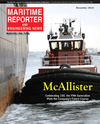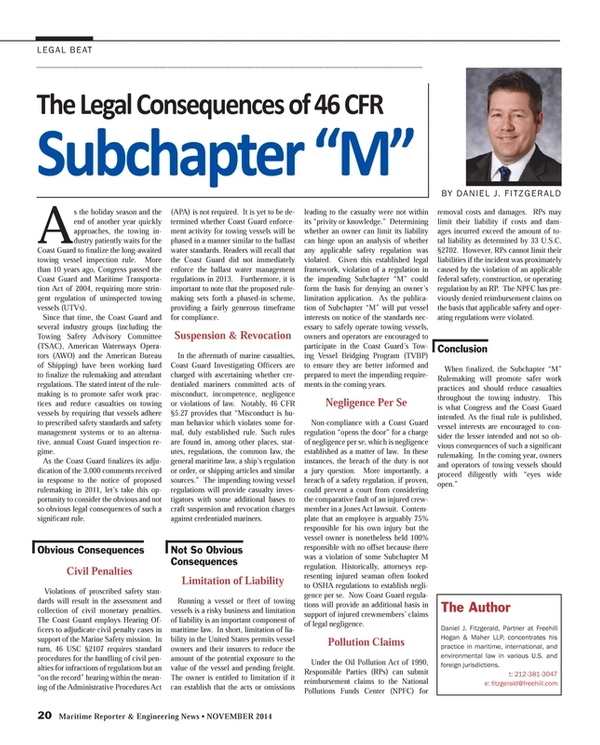
The Legal Consequences of 46 CFR Subchapter “M”
As the holiday season and the end of another year quickly approaches, the towing industry patiently waits for the Coast Guard to finalize the long-awaited towing vessel inspection rule. More than 10 years ago, Congress passed the Coast Guard and Maritime Transportation Act of 2004, requiring more stringent regulation of uninspected towing vessels (UTVs).
Since that time, the Coast Guard and several industry groups (including the Towing Safety Advisory Committee (TSAC), American Waterways Operators (AWO) and the American Bureau of Shipping) have been working hard to finalize the rulemaking and attendant regulations. The stated intent of the rulemaking is to promote safer work practices and reduce casualties on towing vessels by requiring that vessels adhere to prescribed safety standards and safety management systems or to an alternative, annual Coast Guard inspection regime.
As the Coast Guard finalizes its adjudication of the 3,000 comments received in response to the notice of proposed rulemaking in 2011, let’s take this opportunity to consider the obvious and not so obvious legal consequences of such a significant rule.
Obvious Consequences
Civil Penalties
Violations of proscribed safety standards will result in the assessment and collection of civil monetary penalties. The Coast Guard employs Hearing Officers to adjudicate civil penalty cases in support of the Marine Safety mission. In turn, 46 USC §2107 requires standard procedures for the handling of civil penalties for infractions of regulations but an “on the record” hearing within the meaning of the Administrative Procedures Act (APA) is not required. It is yet to be determined whether Coast Guard enforcement activity for towing vessels will be phased in a manner similar to the ballast water standards. Readers will recall that the Coast Guard did not immediately enforce the ballast water management regulations in 2013. Furthermore, it is important to note that the proposed rulemaking sets forth a phased-in scheme, providing a fairly generous timeframe for compliance.
Suspension & Revocation
In the aftermath of marine casualties, Coast Guard Investigating Officers are charged with ascertaining whether credentialed mariners committed acts of misconduct, incompetence, negligence or violations of law. Notably, 46 CFR §5.27 provides that “Misconduct is human behavior which violates some formal, duly established rule. Such rules are found in, among other places, statutes, regulations, the common law, the general maritime law, a ship’s regulation or order, or shipping articles and similar sources.” The impending towing vessel regulations will provide casualty investigators with some additional bases to craft suspension and revocation charges against credentialed mariners.
Not So Obvious
Consequences
Limitation of Liability
Running a vessel or fleet of towing vessels is a risky business and limitation of liability is an important component of maritime law. In short, limitation of liability in the United States permits vessel owners and their insurers to reduce the amount of the potential exposure to the value of the vessel and pending freight. The owner is entitled to limitation if it can establish that the acts or omissions leading to the casualty were not within its “privity or knowledge.” Determining whether an owner can limit its liability can hinge upon an analysis of whether any applicable safety regulation was violated. Given this established legal framework, violation of a regulation in the impending Subchapter “M” could form the basis for denying an owner’s limitation application. As the publication of Subchapter “M” will put vessel interests on notice of the standards necessary to safely operate towing vessels, owners and operators are encouraged to participate in the Coast Guard’s Towing Vessel Bridging Program (TVBP) to ensure they are better informed and prepared to meet the impending requirements in the coming years.
Negligence Per Se
Non-compliance with a Coast Guard regulation “opens the door” for a charge of negligence per se, which is negligence established as a matter of law. In these instances, the breach of the duty is not a jury question. More importantly, a breach of a safety regulation, if proven, could prevent a court from considering the comparative fault of an injured crewmember in a Jones Act lawsuit. Contemplate that an employee is arguably 75% responsible for his own injury but the vessel owner is nonetheless held 100% responsible with no offset because there was a violation of some Subchapter M regulation. Historically, attorneys representing injured seaman often looked to OSHA regulations to establish negligence per se. Now Coast Guard regulations will provide an additional basis in support of injured crewmembers’ claims of legal negligence.
Pollution Claims
Under the Oil Pollution Act of 1990, Responsible Parties (RPs) can submit reimbursement claims to the National Pollutions Funds Center (NPFC) for removal costs and damages. RPs may limit their liability if costs and damages incurred exceed the amount of total liability as determined by 33 U.S.C. §2702. However, RPs cannot limit their liabilities if the incident was proximately caused by the violation of an applicable federal safety, construction, or operating regulation by an RP. The NPFC has previously denied reimbursement claims on the basis that applicable safety and operating regulations were violated.
Conclusion
When finalized, the Subchapter “M” Rulemaking will promote safer work practices and should reduce casualties throughout the towing industry. This is what Congress and the Coast Guard intended. As the final rule is published, vessel interests are encouraged to consider the lesser intended and not so obvious consequences of such a significant rulemaking. In the coming year, owners and operators of towing vessels should proceed diligently with “eyes wide open.”
The Author
Daniel J. Fitzgerald, Partner at Freehill Hogan & Maher LLP, concentrates his practice in maritime, international, and environmental law in various U.S. and foreign jurisdictions.
t: 212-381-3047
e: [email protected]
Read The Legal Consequences of 46 CFR Subchapter “M” in Pdf, Flash or Html5 edition of November 2014 Maritime Reporter
Other stories from November 2014 issue
Content
- Editorial: 75, 150 ... What’s in a Number? page: 6
- Is Glycerine the Next Marine Fuel? page: 16
- The Legal Consequences of 46 CFR Subchapter “M” page: 20
- Avoiding the Edges of the Sea page: 22
- Will Congress Pass Any Maritime Legislation in 2014? page: 26
- World’s Largest Containership First Tested at MARIN page: 30
- What’s All the Noise at IMO? page: 34
- From Security to Efficiency Modern Vessel Tracking page: 40
- Marine Insurance & the “Human Factor” page: 44
- Subsea Defense & the Changing Paradigm of Submarine Programs page: 48
- ZF Geared up for a Commerical Maritime Push page: 52
- Interview: Matthew Paxton, President, Shipbuilders Council Of America page: 58
- Offshore: Ulstein and the First U.S. Built X-Bow page: 66
- OilCraft’s TwinBow Challenge page: 74
- The McAllister Towing Legacy page: 76
- Denet Towing Repower Saves 20% in Fuel page: 92
- Eltorque Pushes into US Market page: 93
- AHTS Proves Strength on (in & through) Ice page: 94
- Kleven Orderbook Pumped up to $1.8b page: 96
- Z-Drive Use Spreads on US Inland Waterways page: 96
- Floating Production: Huge Opportunity for Shipyards, Manufacturers page: 98
- Special Vessels “Built by Flensburger” page: 100
- Danish Maritime Takes Center Stage page: 104
- Safety is Job One page: 110
- Focus: Heavy Duty Lifting page: 114
- Lifting Costa Concordia page: 118
- RV Sikuliaq: Modern Electric Propulsion & Power Management page: 122
- Talking Turbines with Bolsinger, VP at GE Marine page: 134
- DSME Returns for More Dual-Fuel Engines page: 138
- Volvo Penta Triple IPS and DP for New Fast Response Boat page: 138
- New Propulsion Couplings from Renold Hi-Tec page: 139
- Cummins Auxiliaries for New OSV page: 139
- Tier III Marine Power: Genset with SCR page: 140
- New Generation of Turbochargers page: 141
- Class Approval for Wärtsilä Steerable Thruster page: 142
- Cat, Deltamarin Develop Modular FPSO Power Unit page: 144
- WEG’s CFW11W Offers Higher Power page: 144
- John Deere Expands Tier 3 Engine Lineup page: 144
- Successful MTG Light Off for USS Zumwalt page: 145
- MJP Introduces Hybrid Waterject page: 145
- This is One, Big Specialty Valve page: 148
- DNV GL Updates Phast Software page: 148
- SGB 2000 Gyrocompass Class Approved page: 148
- B COOL A/S Acquires Memac page: 148
- Hatteland’s 20-inch Display page: 148
- New Cutting Machine from ESAB page: 148
- Shell Launches App to Track Marine Lube Orders page: 148
- Hempel Launches AvantGuard Primers page: 150
- Underwater Locator Beacons for VDR page: 150
- Automatic Lubrication System for Shell’s Prelude page: 150
- Livorsi Launches New Throttle Lineup page: 150
- Delta-Y Assembly for Offshore Oil Bulk Cement/Barite Piping Systems page: 150
- Cummins Debuts Mobile Tier 4 Generators page: 150
- New Heater Kits for Northern Sea Route Vessels page: 151
- New Plasma Cutting and Gouging System page: 151
- New Simulation Tool for Collision Reconstruction page: 151
- ACO Unveils New Plant for Upcoming Wastewater Rules page: 151
- Survitec Escape Slide for Norwegian Ferry page: 151
- New Rolling Bearing Grease from Klüber page: 151
- KO-LINK Towing Ring from Lankhorst Ropes page: 151
- New Gear Grease and Oils from Klüber page: 152
- Portable Fire Extinguishers page: 152
- Self-Leveling, Height Adjustable Chocks page: 152
- ESAB’s New Welding Wire page: 152
- PalmScope Video Inspection System page: 152
- J D Neuhaus Hydraulic Lifts page: 152
- Flow Control for Multi-pump Applications page: 152


